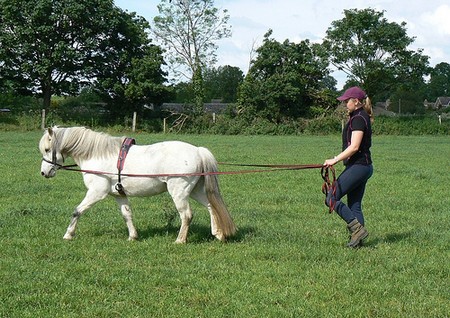Long reining is commonly used to introduce young or unbroken horses to ridden work by allowing them to experience a bridle, bit and saddle without a rider. However, as any exercise that can be carried out in the saddle can also be achieved with long reining, it is a very useful way of training horses throughout their working life.
As with lunging, both you and horse can benefit-you can watch the horse performing the movements, while the horse gains a better understanding of the exercises before carrying a rider. Furthermore, the young horse is given the opportunity to gain strength and flexibility throughout its body prior to being ridden.
Equipment
There are different types of long reining but here we shall focus on the English method, which involves using two reins of at least 30 ft (9 m) each. The horse should wear a saddle with the stirrup irons down at full length and secured together safely by a strap passing under the belly. This means that the leathers have been safely adapted for the reins to slip through. Alternatively, a surcingle can be worn that is secured firmly around the horse’s girth region and has rings on either side for the reins to pass through.
The reins must be of equal length. They attach to the bit rings on either side of the bridle, then pass through the stirrups or the rings of the surcingle. The reins should be held in the same manner as when riding a horse. For safety, you should keep at a distance of at least 10 ft (3 m) from the horse at all times and wear gloves, sturdy boots and a hard hat.
Starting work
Encourage the horse to move forward on a large circle by using either your voice and the reins, or the whip. Keep the horse moving in a positive and active manner at all times. For everyone’s safety, it is important to stay slightly to one side of the horse, where you will remain in its view, rather than standing directly behind-young horses in particular prefer to keep their handler in their sights.
Use experienced help
Always have an experienced professional with you when you first begin long reining as there is a lot to think about and large animals can be unpredictable, particularly when frightened or unsure of what is being asked of them. It is good practice to have an assistant walk at the horse’s head to calm and direct it until it understands what you are asking it to do.
Circles
The initial aim of long reining is for the horse to move in a relaxed and forward-going manner. This is best achieved by working the horse in walk on a large circle at least 50 ft (15 m) in diameter. Big circles are ideal for training horses, particularly young ones, as they are large enough for the horse to keep its balance yet still encourage flexion from the side of its body on the outside of the circle by bending its body slightly to the inside. You must also keep walking in order to keep up with the horse and will need to use your voice, reins, position and, if necessary, the whip to control the horse’s pace.
At this point, you are teaching the horse the basics of control and obedience. Working on a circle you should ask the horse to walk, trot and halt in response to your aids, aiming to make your aids gradually more discreet as the horse begins to understand what you are asking. It is rewarding to see how quickly a human and horse can build a trusting relationship between each other as these drills and exercises develop.
Serpentines and figure-eights
Once you and the horse are proficient with the aids, more complex movements such as a serpentine can be performed. The serpentine requires the horse to carry out a series of changes in direction while continually moving forward. Keep the horse in front of you at all times so that it can be steered to the left for half a circle then directed to the right and so on. Once you are competent with the serpentine, try performing figure-eights, but once again concentrating on control and encouraging a rhythmic, active pace from the horse at all times.
Straight lines
Long reining work should also be done in straight lines. This is much harder than it appears as horses are very prone to “wobble” if they have not been taught to move straight without relying on assistance. Begin by walking the horse in a straight line alongside a wall or fence to keep him on a true line. Next, walk him approximately 1 foot (30 cm) away from the fence while still aiming to achieve a straight line.
Continue until the horse learns to move in a straight line without anything near him that he can use as a guide.
Standing still
One of the most important skills you can teach a horse is to stand patiently and still between exercises. This is vital for safety and also the foundation of good manners that will be a benefit to the horse for the rest of its life.

